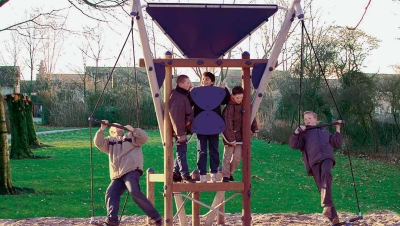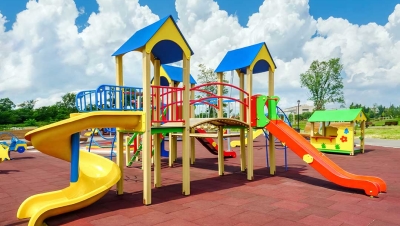Bringing Playground Equipment to Life
With Special Guests Janet Sanchez, Jane Nowell, Cristina Brandon and their wonderful Fourth Grade Students
Our profession works very hard to make playgrounds safe, enjoyable places for children to grow. To bring in the New Year, I have asked an outstanding team of teachers and students to tell us about their very special game and experiences on the playground at their school. They did a great job and I would like to thank them very much.
The Game of Dead Mummy
The Eagle’s Nest is where dead mummies come to life in Albuquerque, New Mexico at Chamiza Elementary School. How do dead mummies come to life? Well, fourth graders bring them to life with a playground game they created.
The Eagle’s Nest is a dome shaped climbing structure (GameTime’s Mountain Climber). All of the horizontal bars form circles. At the bottom of the structure they are larger in diameter than at the top of the structure. There is room to play in the center of the structure as well. The ground cover of the play area is wood chips (Engineered Wood Fiber).
The game starts with an “it” person called “Dead Mummy.” The dead mummy is “dead” while he or she stands or sits on the ground in the middle of the Eagle’s Nest. As soon as the other players chant, “Dead mummy, dead mummy, come alive by the time I count to five. 1-2-3-4-5. Come alive!” Then, the dead mummy starts climbing the Eagle’s Nest to tag another player who will be “it.”
This is no ordinary tag game because the dead mummy must climb and tag with his or her eyes closed. That’s only the beginning of the rules. There are many rules, which allow up to five players to face challenges and experience science. If more than five players are involved, it gets too crowded to move around the structure.
Dead Mummy Rules
- The mummy must always have his or her eyes closed. If he or she opens his eyes, he or she risks being called silly names.
- The mummy can touch the ground, as long as it’s the ground inside the Eagle’s Nest.
- The mummy’s goal is to tag another person to be “it.”
- If the mummy tags someone they don’t want to tag, they can take the tag back and try to get who they want again, although they can only do this once.
- A player may only be the dead mummy for a maximum of 5 times per recess.
- To start the game, whoever arrives last is “it” or the dead mummy.
Player Rules
- Cannot stand on the top bar (because it interferes with the imaginary eagles in the nest).
- Can’t jump off the Eagle’s Nest or touch the ground or you’re automatically “the mummy.”
- Players keep the mummy safe by warning them if they’re running into anything. They warn the mummy by gently tugging their shirt or shouting, “Watch out!” They get warned when they’re going to hit their head or face on a bar or another player, if they’re going to miss a grab for a bar, or when the mummy is going to trip on something on the ground in the center of the Eagle’s Nest.
- When playing, players can have nicknames but they have to be nice names. They reflect how they play the game. For example, Butterfingers may mean the player’s hands slip off the bar. The nickname Turtle or Big Papa may mean the player is slow, or Buttercup may mean you fall off the bars easily.
The Challenges
- To create a diversion for the mummy, some players take off their shoe and throw it on the ground so they can go get it. This strategy allows them to avoid becoming “it.” The mummy doesn’t know he or she is being avoided because their eyes are closed.
- Players aren’t supposed to talk. It’s not a good strategy to talk because sound is the key sense mummies use to tag a particular player.
- Players can guess if the mummy is going after a particular player. Players may work together to block the player the mummy is going after so the mummy can’t get them.
- Another trick is to hide on the bottom bar of the Eagle’s Nest by laying down on the bar without touching the ground or hang from the bars with your hands so you can swing out of the way.
Special Rules for Newcomers
New players have a couple of details explained before they start. They may also watch an example round. They truly learn by trial and error.
The Science
The mummy has to listen to sounds and feel how the poles vibrate to find players to tag. Other key sounds to listen for are wood chips from falling shoes, talking, whispering, and shoes squeaking. All these sound waves and vibrations lead the mummy to find a replacement.
One of the surprising things about this creative game is that it all gets played in less than 15 minutes and has many variations. If the dead mummy game gets tiring, students talk about how the Eagle’s Nest reminds them of the center of the earth because it starts with little circles at the top, which remind them of the Earth’s core. The circles get bigger and bigger like the layers of the earth. Then you have the beginning of a new game created by nine and ten year-olds.
I think we are getting it right! Please use this month’s column to remember why you do what you do and to help keep you motivated when issues arise. We all work hard, but can you ask for a better reason than children like these? The PlaySafe, LLC Family would like to wish you a happy and healthy new year.



















I love this article it is
I love this article it is really accurate, and I would know because I was in the picture at the top and was in Mrs.sanchez's and Ms. Noel's class for 4th grade.
Unsafe Playground Fall Safety Standards & Surfaces
Unfortunately, IPEMA, U.S. CPSC, ASTM and other agencies appear to have stuck their collective heads somewhere when it comes to playground fall safety. Why else would they choose to ignore over 14-year-old data from the VERY SAME National Highway Traffic Safety Administration (NHTSA) whose crash test data was used to establish playground fall safety standards. When the March 2000 NHTSA Report stated 1000 HIC is unsafe, 700 HIC is the threshold for likely permanent disability or death for ages 6 to adult, 570 HIC for ages 4-5, and 390 HIC for ages 1-3, it proves the playground industry may care more about profits than safety for our kids. In addition, monolithic or unitary surfaces are dreadful when it comes to impact attenuation, inasmuch that they return the collected kinetic energy from the point of compression impact toward the child while they're still falling in a downward motion, thereby creating much more horrific injuries.